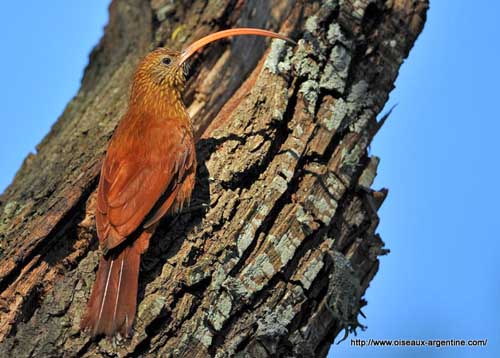
PROTECTION / THREATS / STATUS:
The Red-billed Scythebill is locally distributed throughout the range, and may be uncommon to fairly common. They are highly sensitive to human disturbances, and their presence also depends on nesting-cavities availability and suitable trees’ species.
The species is evaluated as Least Concern by Birdlife International.
Fr: Grimpar à bec rouge
All : Rotrücken-Sensenschnabel
Esp: Picoguadaña Piquirrojo
Ital: Becco a scimitarra colibrì
Nd: Kolibrie-muisspecht
Sd: Rödnäbbad skärnäbb
Port: Arapaçu-beija-flor
Photographers :
Philippe et Aline Wolfer
GALERIE
Text by Nicole Bouglouan
Sources :
HANDBOOK OF THE BIRDS OF THE WORLD Vol 8 By Josep del Hoyo-Andrew Elliott-David Christie - Lynx Edicions - ISBN: 8487334504
L’ENCYCLOPEDIE MONDIALE DES OISEAUX - Dr Christopher M. Perrins - BORDAS - ISBN: 2040185607
Arthur Grosset's Birds (Arthur Grosset)
BirdLife International (BirdLife International)
Wikipedia, the free encyclopaedia
XENO-CANTO – Sharing Birds sounds from around the world
Red-billed Scythebill
Campylorhamphus trochilirostris
Passeriforme Order – Furnariidae Family
BIOMETRICS:
Length: 22-28 cm
Weight: 34-55 g
DESCRIPTION:
The Red-billed Scythebill exhibits fairly marked geographical variations in plumage, songs and habitat preferences. Several subspecies are included in this species, which some differences in colour and pattern, but all have the conspicuous down-curved bill, typical of this genus.
The adult of nominate race has finely streaked face and neck, and indistinct supercilium. Crown and nape are brownish-olive and darker than the back which is more reddish. The crown shows whitish to ochraceous elongate spots with narrow blackish edges. These spots become narrower and more elongate on the nape, ending in fine streaks on the back. The brown back blends into the cinnamon-rufous rump.
Flight feathers and rectrices are rufous-chestnut with the tail slightly darker. The wing-coverts are edged reddish olive-brown, and the primary flight feathers have dusky tips. The stiff rectrices are spiny and curved like claws, and are able to support the bird’s weight, making easier climbing to the tree trunks.
Chin and throat are white with narrow brownish streaks on the throat. The underparts are brown, slightly paler than above. The breast is streaked pale buff. These streaks are narrower and shorter on belly, and are lacking on vent and undertail-coverts. The underwing-coverts are pale cinnamon to ochraceous.
The strongly decurved bill is bright red to reddish-brown, often with dusky base and tip. The eyes are dark brown to hazel. Legs and feet are greyish-olive.
Both sexes are similar, but the female is slightly smaller than the male.
The juvenile has less coloured plumage with faint streaking. The bill is shorter and darker.

The race displayed here is C.t. hellmayri, with pictures taken in N Argentina.
This subspecies is larger than nominate, with longer and more robust bill. There are some differences in plumage. This one has chin and throat similar to the breast, whereas the nominate race has white ones. The streaks on head, neck and breast are narrower and duller, and the body plumage is more reddish overall, especially on the underparts.
The other subspecies differ in streak-pattern (more or less contrasted), body and bill size, and more or less reddish plumage.
VOICE: SOUNDS BY XENO-CANTO
The Red-billed Scythebill’s songs are highly variable according to the subspecies and the situation. The same bird may utter two different songs, a rapid descending whinny of several musical notes ending in slower notes, and a rapid trill of numerous notes, sharply ascending, slowing slightly and sometimes doubled. The latter is often given by excited birds.
Other songs are descending series of some whistled notes slowing gradually. Several variations are uttered with similar quality but different timing.
When the birds are excited, we can hear descending series of loud, musical “chip” notes. The alarm call is an explosive “chi-dik” often repeated.
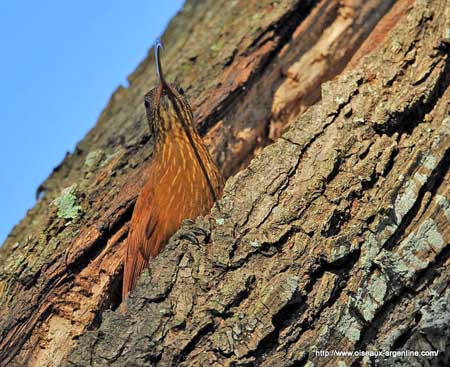
HABITAT:
The Red-billed Scythebill is a forest species which occurs in several types of wooded habitats in lowlands and foothills, but often in open areas. It can be seen in deciduous and gallery forests, forest patches in savannahs, forest edges, second growths and scrubby habitats.
They usually frequent tropical lowlands and foothills up to 1200 metres of elevation, but some races may occur up to 2100 metres in the Andean foothills and the coastal mountains. It is less frequently found in humid evergreen forests.
RANGE:
The Red-billed Scythebill has wide range in South America. It is found in Argentina, Bolivia, Brazil, Colombia, Ecuador, Panama, Paraguay, Peru and Venezuela.
BEHAVIOUR:
The Red-billed Scythebill is primarily insectivorous, feeding on arthropods and spiders. Some small vertebrates are apparently taken too. The usual preys are relatively small, less than 20mm. The larger preys are hit against the tree trunk before to be swallowed.
The long down-curved bill allows the bird to hunt where the other birds with normal bill could not reach the food items. Once the prey is caught in the bill tip, it throws back the head and drops the food into its mouth.
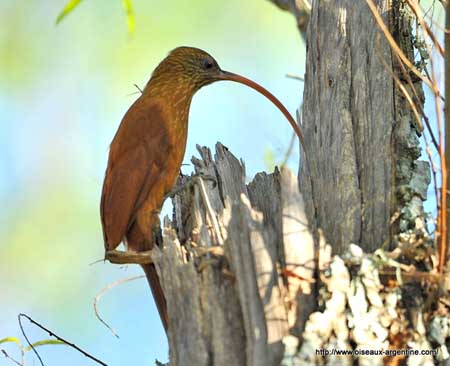

The Red-billed Scythebill is usually seen alone or occasionally in pairs, and it often joins mixed-species flocks. It forages on trunks and branches from the upper undergrowth to the subcanopy, but it may also forages higher or lower.
This bird moves rapidly and continuously, and it is difficult to observe. It rarely remains motionless for more than a few seconds. It uses the stiff tail as the woodpeckers do.
When alarmed, it hides on the rear surface of the trunk. The roosting behaviour is poorly known, but it usually roosts solitary and in cavities. It may become aggressive when defending the territory. The pair excludes the intruders from the understorey flocks, but intrusions are allowed into the area if the intruder does not attempt to join the flock. This territory defence is limited to the close vicinity of the flocks.
This species is resident and territorial all year round.
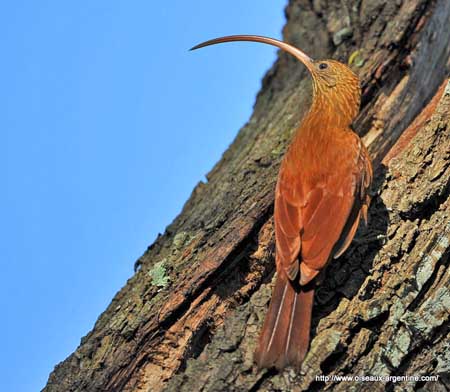
FLIGHT:
The Red-billed Scythebill is mainly an arboreal species, but it moves from trunk to trunk with strong, slightly undulating flight. It has broad wings with rounded tips.
REPRODUCTION:
The breeding season varies according to the range, but it is often associated to the seasonal rains.
The Red-billed Scythebill nests in natural cavities, a hole in tree or stump, between one and five metres above the ground. The hole is lined with leaves and materials from the same tree.
The cavity is not excavated by the Red-billed Scythebill, but some races may enlarge the entrance. They may use abandoned termite nests, or hole in hollow bamboo pole and at bases of palm fronds. They also may use abandoned woodpecker holes and even abandoned nest of Rufous Hornero.
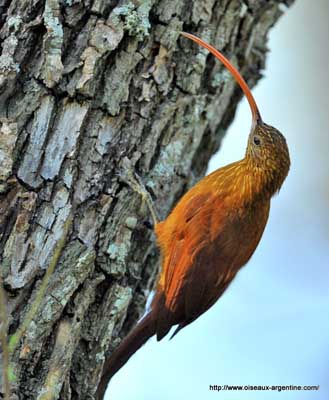
The female lays two white eggs (1-3). The nesting behaviour is unknown, but from an observation, a male has been found with a brood patch, suggesting that both sexes share all the nesting duties. The incubation lasts between two and three weeks, and the young fledge three weeks after hatching.
DIET:
The Red-billed Scythebill feeds on arthropods and mainly soft-bodied items such as spiders. It may also take some small vertebrates. Several insect species are included in its diet such as beetles, flies, ants, Lepidoptera, cockroaches, millipedes and insect larvae.
It forages by probing in bark crevices, fallen logs and rotting wood, but also in clumps of moss, bromeliads and epiphytes.
